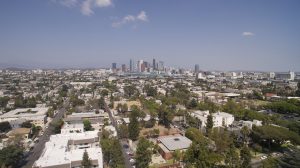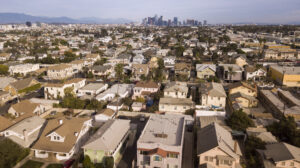
Home Affordability in the USC Area
In 2006, when USC began planning its new mixed-use “Village” development, the UNIDAD Coalition ––a group of community-based organizations in South Central–– arose to ensure
Variable Definitions:
Median Year Built for All Units: The median year that the residential structures in the area were built. Year built refers to when the building was first constructed, not when it was remodeled, added to or converted.
Median Year Built for Rental Units: The median year that the rental structures in the area were built. Year built refers to when the building was first constructed, not when it was remodeled, added to or converted.
Median Year Built for Owner Units: The median year that the owner structures in the area were built. Year built refers to when the building was first constructed, not when it was remodeled, added to or converted.
Other Notes:
The American Community Survey has a minimum estimated year built at 1940. All census tracts with a median year of construction for buildings of before 1940 are shown as 1940.
Source:
American Community Survey, 5-year estimates, Table B25037
Years Available:*
2023
*Note: Each year of available data shown above is a 5-year estimate, or an average of data collected over a five year period. 5-year estimates are used to increase the reliability of the data at small geographies like neighborhoods and census tracts. The years shown on the NDSC map represent the final year of the five year average (e.g. “2010” represents 2006-2010 data, “2011” represents 2007-2011 data, and so on). For the most impactful comparison of data over time, the ACS recommends comparing non-overlapping years (e.g. 2010-14 with 2015-19).
The median year built for structures in any given area means that half of the housing stock in the area was built before that year, and the other half of the housing stock was built after that year.
This metric illustrates how housing in Los Angeles has developed throughout the decades. Housing development started in the city-center and gradually expanded out as rapid population growth necessitated more and more housing. Neighborhoods near the border of Los Angeles city, such as Chatsworth and Granada Hills, were fully developed by the end of the 20th century. The 1940s through 1950s had a dramatic increase in housing. In the 1960s and 1970s, developments began to spread through the South Bay and into San Fernando Valley. By the 1980s, development slowed down and this trend carried on through to the 21st century, favoring single-family development as opposed to high density of multifamily structures.
Despite the demand and relatively high rate of housing production in the 20th century, the rate of housing development has slowed considerably relative to population growth. This could be a result of rising development costs and a shortage of skilled labor, or local community pushback to new developments. Moderate-sized multifamily developments have especially been on a sharp decline since their peak in the 1960s-80s as single-family homes and higher density developments take up the largest share of new developments.
Housing growth has slowed considerably in Los Angeles compared to larger geographies of analysis. Los Angeles City and Los Angeles County have a similar median year built for their housing stock; however, zooming out further reveals that the median age becomes younger and younger. For instance, Los Angeles’ median age of housing stock is 1965, whereas California’s median age of housing stock is 1977. The median age of housing stock in the whole United States is 1981, 16 years younger than the stock in Los Angeles, which indicates that Los Angeles is on the slower end of the spectrum in terms of housing production in the United States.

In 2006, when USC began planning its new mixed-use “Village” development, the UNIDAD Coalition ––a group of community-based organizations in South Central–– arose to ensure

According to the Economic Policy Institute (EPI), 8.4 million jobs have been lost since the start of the pandemic in February 2020, and over 5 million people

Across the nation, the population experiencing homelessness is getting older. The end of the Baby Boomer generation (those born between 1955 and 1964) have faced
